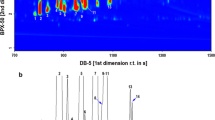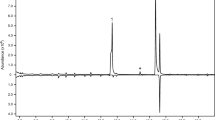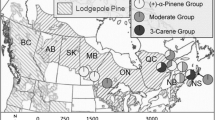Abstract
Ips typographus beetles were collected in the field, separated into eight attack phases (from beetles walking on the trunk of a tree under attack to those excavating gallery systems with a mother gallery longer than 4 cm), and immediately frozen in liquid nitrogen. 2-Methyl-3-buten-2-ol,cis- andtrans-verbenol, verbenone, myrtenol, trans-myrtanol, ipsenol, ipsdienol, and 2-phenylethanol were quantified from excised hindguts against an internal standard, heptyl acetate, in the extraction solvent. Methylbutenol, the pinene alcohols, and 2-phenylethanol showed the same pattern of variation between attack phases in males, with the largest amounts present before accepting females and then a fast decline. Ipsenol and ipsdienol were not detected in males before the females were accepted, and the amounts increased when the females start their egg laying. Verbenone occurred only in trace amounts. The beetles were sampled from five Norway spruce trees (Picea abies) of differing resin flow. The correlations between the nine pheromone components and five major host monoterpenes in the gut showed that the variation in the amount of methyl-butenol, ipsenol, and ipsdienol could not be explained by the variation in the amounts of host monoterpenes. In contrast over 80% of the quantitative variation ofcis-verbenol,trans-verbenol, and myrtenol was explained by the amount of α-pinene. The nine pheromone components from 36 individual males were also quantified. Both methylbutenol andcis-verbenol showed a large variation in both amounts and proportions. Females containedtrans-verbenol and traces of most other components found in males. When accepted by the male, they also contained a female-specific compound, β-isophorone. Behavioral and biosynthetic implications of the results are discussed.
Similar content being viewed by others
References
Bakke, A. 1970. Evidence of a population aggregating pheromone inIps typographies (Coleoptera: Scolytidae).Contrib. Boyce Thompson Inst. 24:309–310.
Bakke, A. 1976. Spruce bark beetle,Ips typographies: Pheromone production and field response to synthetic pheromones.Naturwissenschaften 63:92.
Bakke, A. 1981. Inhibition of the response inIps typographies to the aggregation pheromone; Field evaluation of verbenone and ipsenol.Z. Angew. Entomol. 92:172–177.
Bakke, A., Fröyen, P., andSkatteböl, L. 1977. Field response to a new pheromonal compound isolated fromIps typographies.Naturwissenschaften. 64:98–99.
Borden, J.H. 1967. Factors influencing the response ofIps confusus (Coleoptera: Scolytidae) to the male attractant.Can. Entomol. 99:1164–1193.
Borden, J.H. 1974. Aggregation pheromones in the Scolytidae, pp. 135–160.In M.C. Birch (ed.). Pheromones. North-Holland, Amsterdam.
Byers, J.A. 1981a. Effect of mating on terminating aggregation during host colonization in the bark beetle,Ips paraconfusus.J. Chem. Ecol. 7:1135–1147.
Byers, J.A. 1981b. Pheromone biosynthesis in the bark beetle,Ips paraconfusus, during feeding or exposure to vapours of host plant precursors.Insect Biochem. 11:563–569.
Byers, J.A. 1982. Male-specific conversion of the host plant compound, myrcene, to the pheromone, (+)-ipsdienol, in the bark beetle,Dendroctonus brevicomis.J. Chem. Ecol. 8:363–371.
Byers, J.A. 1983. Sex-specific response to aggregation pheromone: Regulation of colonization density in the bark beetle,Ips paraconfusus.J. Chem. Ecol. 9:129–142.
Byers, J.A., andWood, D.L. 1980. Interspecific inhibition of the response of the bark beetles,Dendroctonus brevicomis andIps paraconfusus, to their pheromones in the field.J, Chem. Ecol. 6:149–164.
Byers, J.A., andWood, D.L. 1981. Interspecific effects of pheromones on the attraction of the bark beetles,Dendroctonus brevicomis andIps paraconfusus in the laboratory.J. Chem. Ecol. 7:9–18.
Byers, J.A., Wood, D.L., Browne, L.E., Fish, R.H., Piatek, B., andHendry, L.B. 1979. Relationship between a host plant compound, myrcene and pheromone production in the bark beetleIps paraconfusus.J. Insect Physiol. 25:477–482.
Coulson, R.N. 1979. Population dynamics of bark beetles.Annu. Rev. Entomol. 24:417–447.
Dickens, J.C. 1981. Behavioural and electrophysiological responses to the bark beetle.Ips typographies, to potential pheromone components.Physiol. Entomol. 6:251–261.
Eidmann, H.H., andNuorteva, M. 1968. Der Einfluss der Siedlungsdichte und anderer Faktoren auf die Anzahl der Nachkommen vonBlastophaguspiniperda L. (Coleoptera: Scolytidae).Ann. Entomol. Fenn. 34:135–148.
Fish, R.H., Browne, L.E. Wood, D.L., andHendry, L.B. 1979. Pheromone biosynthetic pathways: Conversions of deuterium labelled ipsdienol with sexual and enantioselectivity inIps paraconfusus Lanier.Tetrahedron Lett. 17:1465–1468.
Francke, W., Sauerwein, P., Vité, J.P., andKlimetzek, D. 1980. The pheromone bouquet ofIps amitinus.Naturwissenschaften 67:147–148.
Hackstein, E., andVite, J.P. 1978. Pheromonbiosynthese und Reizkette in der Besiedlung von Fichten durch den Buchdrucker.Ips typographus. Mitt. Dtsch. Ges. Allg. Angew. Entomol. 1:185–188.
Hendry, L.B., Piatek, B., Browne, L.E., Wood, D.L., Byers, J.A., Fish, R.H., andHicks, R. A. 1980.In vivo conversion of a labelled host plant chemical to pheromones of the bark beetleIps paraconfusus.Nature. 284:485.
Hughes, P.R. 1973.Dendroctonus: Production of pheromones and related compounds in response to host monoterpenes.Z. Angew. Entomol. 73:294–312.
Hughes, P.R. 1974. Myrcene: A precursor of pheromones inIps beetles.J. Insect. Physiol. 20:1271–1275.
Hughes, P.R. 1975. Pheromones ofDendroctonus: Origin of α-pinene oxidation products present in emergent adults.J. Insect Physiol. 21:687–691.
Krawielitzki, S., Klimetzek, D., Bakke, A., Vité, J.P., andMori, K. 1977. Field and laboratory reseponse ofIps typographus to optically pure pheromonal components.Z. Angew. Entomol. 83:300–302.
Lanier, G.N., Claesson, E., Stewart, T., Piston, J.J., andSilverstein, R.M. 1980.Ips pint: The basis of interpopulational differences in pheromone biology.J. Chem. Ecol. 6:677–687.
Lie, R., andBakke, A. 1981. Practical results from the mass trapping ofIps typographus in Scandinavia, pp. 175–181,in E.R. Mitchell (ed.). Management of Insect Pests with Semiochemicals. Plenum Press, New York.
Löyttyniemi, K., Austar», Ö., Bejer, B., andEhnstrÖm, B. 1979. Insect pests in forests of the Nordic countries 1972–1976.Folia For. 395:1–13.
Miller, J.R., andRoelofs, W.L. 1980. Individual variation in sex pheromone component ratios in two populations of the redbanded leafroller moth,Argyrotaenia velutinana.Environ. Entomol. 9:359–363.
Nie, N., Hull, H., Jenkins, J., Steinbrenner, K., andBent, D. 1975. SPSS: Statistical Package for the Social Sciences. McGraw-Hill, New York. 675 pp.
Ogibin, B.N. 1972. Sex ratio and size of beetles of young generation with respect to different population density ofIps typographus (Coleoptera, Ipidae).Zool. Zhur. 52:1417–1419.
Postner, M. 1974. Scolytidae, Borkenkäfer, pp. 334–482,in W. Schwenke (ed.). Die Forstschädlinge Europas, 2. Paul Parey, Hamburg-Berlin.
Renwick, J.A.A., andDickens, J.C. 1979. Control of pheromone production in the bark beetle,Ips cembrae.Physiol. Entomol. 4:377–381.
Renwick, J.A.A., andVité, J.P. 1981. Biology of pheromones.Chem. Pflanzenschutzschädlingsbekämpfungsmittel. 6:1–28.
Renwick, J.A.A., Hughes, P.R., andKrull, I.S. 1976. Selective production ofcis- andtrans-verbenol from (−)- and (+)-α-pinene by a bark beetle.Science. 191:199–201.
Rudinsky, J.A., Novák, V., andŠvihra, P. 1971. Pheromone and terpene attraction in the bark beetleIps typographus L.Experientia 27:161–162.
Schlyter, F., andCederholm, I. 1981. Separation of the sexes of living spruce bark beetles,Ips typographus (L.) (Coleoptera: Scolytidae).Z. Angew. Entomol. 92:42–47.
Silverstein, R.M., Rodin, J.O., andWood, D.L. 1966. Sex attractants in frass produced by maleIps confusus in ponderosa pine.Science 154:509–510.
Sokal, R.R., andRohlf, F.J. 1969. Biometry. The Principles and Practice of Statistics in Biological Research. Freeman, San Franisco.
Southwood, T.R.E. 1978. Ecological Methods. Chapman and Hall, London. 524 pp.
Stoakley, J.T., Bakke, A., Renwick, J.A.A., andVitÉ, J.P. 1978. The aggregation pheromone system of the larch bark beetle,Ips cembrae Hear.Z. Angew. Entomol. 86:174–177.
Švihra, P. 1982. Influence of opposite sex on attraction produced by pioneer sex of four bark beetle species cohabiting pine in the southern United States.J. Chem. Ecol. 8:373–378.
Swigar, A.A., andSilverstein, R.M. 1981. Monoterpenes. Aldrich Chemical Co., Milwaukee, Wis. 130 pp.
Thatcher, R.C.,Scarcy, J.L.,Coster, J.E., andHertel, G.D. (eds.). 1981. The Southern Pine Beetle. U.S.D.A. Forest Service Science and Education Administration Technical Bulletin 1631. 267 pp.
Vité, J.P., Bakke, A., andRenwick, J.A.A. 1972. Pheromones inIps (Coleoptera: Scolytidae): Occurrence and production.Can. Entomol. 104:1967–1975.
Vité, J.P., Bakke, A., andHughes, P.R. 1974. Ein Populations lockstoff des zwölfzähnigen KiefernborkenkäfersIps sexdentatus.Naturwissenschaften 61:365–366.
White, R.A., Jr., Agosin, M., Franklin, R.T., andWebb, J.W. 1980. Bark beetle pheromones: Evidence for physiological synthesis mechanisms and their ecological implications.Z. Angew. Entomol. 90:255–274.
Widmer, E. 1977. Process for the manufacturing of oxo compounds. U.S. Patent 4,005,145.
Wood, D.L. 1970. Pheromones of bark beetles, pp. 301–316,in D.L. Wood, R.M. Silverstein, and M. Nakajima (eds.). Control of Insect Behavior by Natural Products. Academic Press, New York.
Wood, D. 1982. The role of pheromones, kairomones, and allomones in the host selection and colonization behavior of bark beetles.Annu. Rev. Entomol. 27:411–446.
Wood, D.L., andBushing, R.W. 1963. The olfactory response ofIps confusus (LeConte) (Coleoptera: Scolytidae) to the secondary attraction in the laboratory.Can. Entomol. 95:1076–1078.
Wood, D.L., Browne, L.E., Silverstein, R.M., andRodin, J.O. 1966. Sex pheromones of bark beetles. I. Mass production, bio-assay, source, and isolation of the sex pheromone ofIps confusus (LeC.).J. Insect Physiol. 12:523–536.
Young, J.C., Silverstein, R.M., andBirch, M.C. 1973. Aggregation pheromone of the beetleIps confusus: Isolation and identification.J. Insect Physiol. 19:2273–2277.
Author information
Authors and Affiliations
Additional information
Coleoptera: Scolytidae.
This study was made within the Swedish project “Odour Signals for Control of Pest Insects.”
Rights and permissions
About this article
Cite this article
Birgersson, G., Schlyter, F., Löfqvist, J. et al. Quantitative variation of pheromone components in the spruce bark beetleIps typographus from different attack phases. J Chem Ecol 10, 1029–1055 (1984). https://doi.org/10.1007/BF00987511
Received:
Revised:
Issue Date:
DOI: https://doi.org/10.1007/BF00987511




